Quantitative analysis of chromatin compaction in living cells using FLIM-FRET
- PMID: 19948497
- PMCID: PMC2779238
- DOI: 10.1083/jcb.200907029
Quantitative analysis of chromatin compaction in living cells using FLIM-FRET
Abstract
We present a quantitative Förster resonance energy transfer (FRET)-based assay using multiphoton fluorescence lifetime imaging microscopy (FLIM) to measure chromatin compaction at the scale of nucleosomal arrays in live cells. The assay uses a human cell line coexpressing histone H2B tagged to either enhanced green fluorescent protein (FP) or mCherry FPs (HeLa(H2B-2FP)). FRET occurs between FP-tagged histones on separate nucleosomes and is increased when chromatin compacts. Interphase cells consistently show three populations of chromatin with low, medium, or high FRET efficiency, reflecting spatially distinct regions with different levels of chromatin compaction. Treatment with inhibitors that either increase chromatin compaction (i.e., depletion of adenosine triphosphate) or decrease chromosome compaction (trichostatin A) results in a parallel increase or decrease in the FLIM-FRET signal. In mitosis, the assay showed variation in compaction level, as reflected by different FRET efficiency populations, throughout the length of all chromosomes, increasing to a maximum in late anaphase. These data are consistent with extensive higher order folding of chromatin fibers taking place during anaphase.
Figures
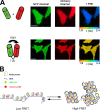
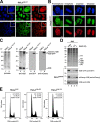
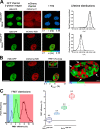
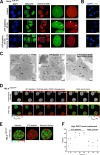
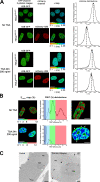
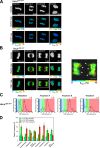
Similar articles
-
Quantifying nuclear wide chromatin compaction by phasor analysis of histone Förster resonance energy transfer (FRET) in frequency domain fluorescence lifetime imaging microscopy (FLIM) data.Data Brief. 2020 Mar 12;30:105401. doi: 10.1016/j.dib.2020.105401. eCollection 2020 Jun. Data Brief. 2020. PMID: 32300614 Free PMC article.
-
Quantitative FLIM-FRET Microscopy to Monitor Nanoscale Chromatin Compaction In Vivo Reveals Structural Roles of Condensin Complexes.Cell Rep. 2017 Feb 14;18(7):1791-1803. doi: 10.1016/j.celrep.2017.01.043. Cell Rep. 2017. PMID: 28199849
-
Phasor histone FLIM-FRET microscopy quantifies spatiotemporal rearrangement of chromatin architecture during the DNA damage response.Proc Natl Acad Sci U S A. 2019 Apr 9;116(15):7323-7332. doi: 10.1073/pnas.1814965116. Epub 2019 Mar 27. Proc Natl Acad Sci U S A. 2019. PMID: 30918123 Free PMC article.
-
The folding and unfolding of eukaryotic chromatin.Curr Opin Genet Dev. 2009 Apr;19(2):159-65. doi: 10.1016/j.gde.2009.02.010. Epub 2009 Apr 5. Curr Opin Genet Dev. 2009. PMID: 19346124 Review.
-
Molecular biology. Chromatin higher order folding--wrapping up transcription.Science. 2002 Sep 13;297(5588):1824-7. doi: 10.1126/science.1074200. Science. 2002. PMID: 12228709 Review.
Cited by
-
The 3D Topography of Mitotic Chromosomes.Mol Cell. 2020 Sep 17;79(6):902-916.e6. doi: 10.1016/j.molcel.2020.07.002. Epub 2020 Aug 7. Mol Cell. 2020. PMID: 32768407 Free PMC article.
-
Histone FRET reports the spatial heterogeneity in nanoscale chromatin architecture that is imparted by the epigenetic landscape at the level of single foci in an intact cell nucleus.Chromosoma. 2024 Jan;133(1):5-14. doi: 10.1007/s00412-024-00815-z. Epub 2024 Jan 24. Chromosoma. 2024. PMID: 38265456 Free PMC article.
-
The Driving Force: Nuclear Mechanotransduction in Cellular Function, Fate, and Disease.Annu Rev Biomed Eng. 2019 Jun 4;21:443-468. doi: 10.1146/annurev-bioeng-060418-052139. Epub 2019 Mar 27. Annu Rev Biomed Eng. 2019. PMID: 30916994 Free PMC article. Review.
-
Decreased DNA density is a better indicator of a nuclear bleb than lamin B loss.J Cell Sci. 2025 Feb 1;138(3):jcs262082. doi: 10.1242/jcs.262082. Epub 2025 Feb 11. J Cell Sci. 2025. PMID: 39501901 Free PMC article.
-
Chromatin histone modifications and rigidity affect nuclear morphology independent of lamins.Mol Biol Cell. 2018 Jan 15;29(2):220-233. doi: 10.1091/mbc.E17-06-0410. Epub 2017 Nov 15. Mol Biol Cell. 2018. PMID: 29142071 Free PMC article.
References
-
- Becker W. 2005. The bh TCSPC handbook. Becker and Hickl GmbH. http://www.becker-hickl.de/handbook.htm(accessed November 27, 2007)
Publication types
MeSH terms
Substances
Grants and funding
LinkOut - more resources
Full Text Sources
Other Literature Sources
Miscellaneous

